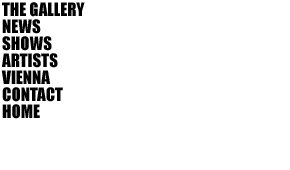
RICHARD
HOECK
Opening: 20/11/2002, 19.00
Duration: 21/11 - 11/01/2003
A COUNTRY LANE
SAM
DURANT / TOBIAS HAUSER / RICHARD HOECK
/ JOHN MILLER
The growing economic importance of a location is not just a factor in
an artist's exhibition in the gallery system but rather in the market-oriented
and politically informed business relationship between real estate brokers
and companies. Controlled living in opposition to the free spirit inherent
in the matter at hand is the basic mood of group show which Richard Hoeck
had initiated with his colleagues Sam Durant, Tobias Hauser and John Miller
in L.A. in the spring of 2002.
The complex processes of co-optation and individual definition of living
space is something that all four artists are preoccupied with in different
ways. In his collages, Sam Durant, an artist living in L.A., breaks the
stringent, modernist interiors of the Case Study Houses with pasted-in
images reflecting the life of the American middle class. Dan Graham, by
contrast, addresses this directly, transforming the glassy nature of this
living aesthetics in various pavilion concepts. This also holds for the
"Rustic hut" modeled after the garden pavilion of the Stadtvilla of the
Viennese gallery owner Christian Meyer. The collaborative project of Richard
Hoeck and John Miller is also based on this construction. As a kind of
"continuation" the two artists adapt the construction using wood and cardboard
to design a "more rustic hut". Here their intention is not to subvert
the reputation of an important postmodern artist but to play down his
aesthetics. And ultimately they want their easily transportable hut to
be able to dock onto the urban network and to leave the protected garden.
The
German artist Tobias Hauser also reacted to the vacant land of Leipziger
Platz in Berlin with a hut, using it as an alienating object in a strategically
constructed outside space. In 2001, he occupied a building deserted by
real estate speculators in 1999 with a simple shingle-roofed hut construction.
This model of the "Walden" hut was to check the surrounding spiraling
economic growth in a transcendental way. This concept relates to Henry
David Thoreau who published an eponymous autobiographic book on this hut
in 1854, appealing to a solitary life in defiance to the decadence of
urbanism.
Each artist created a very personal synthesis of his/her understanding
of anti-aesthetics with the model of the private and public sphere. While
the "Walden" hut may have become a programmatic manifesto for the "Unabomber"
who opposes a society threatened by corporate expansion, the idiom of
the individual pieces remains focused on alternative visions of life and
urbanity. Similar to Sam Durant's deconstruction of the modernist house
and the hut constructions created by Hoeck and Miller as early as 1998
at the Vienna Kunsthalle, all four artists use these notions of architecture
to examine the dangers of political economy. But without forgetting (and
in keeping with the title of the exhibition: "A Country Lane" taken from
a title of Wendy Carlos' original sound track for "Clockwork Orange")
to simply have a bit of fun in the company of friends.
Sam Durant
(1961/USA), lives and works in L.A., 2003 Kunstverein Düsseldorf,
2002 Museum of Contemporary Art, Los Angeles, Color Pictures, Blum & Poe,
Santa Monica, 1998 Into the Black, Kapinos, Berlin
Tobias Hauser (Germany/1959) lives and works in Berlin, 2002 Walden,
Leipziger Straße, Berlin, 2001 Natürliche Todesursachen und andere Gründe,
Zwinger Galerie, Berlin, 1998 U-Neues Deutschland-Fin de Siècle, F.M.
Schwarz, Cologne
Richard Hoeck (A/1965), lives and works in Vienna and Istanbul,
2002 Lobby in Rear, Mackey - Appartment Garage, L.A., 2000 The Additional
Bedroom, Galerie für zeitgenössische Kunst, Leipzig, 1998 White Studies,
Kunsthalle Wien, Vienna
John Miller (USA/ 1954), lives and works in New York und Berlin,
2002 Topology for a Museum (without walls), Kunstraum Johann Widauer,
Innsbruck, 2001 Double Date, Galerie Barbara Weiss, Berlin, 2000 Pilot,
Richard Telles Fine Arts, Los Angeles, 1998 White Studies, Kunsthalle
Wien (mit Richard Hoeck)

